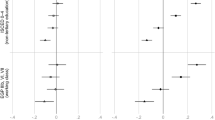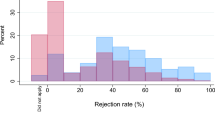Abstract
Within the past decade, there has been a growing number of studies examining undermatch—when students apply to or enroll in institutions less selective than their academic qualifications permit. To estimate undermatch, researchers must define institutions’ selectivity levels and determine which students are eligible to gain admission to these selectivity levels. Researchers examining undermatch have used different approaches to defining institutional selectivity and student qualifications. This, in turn, has produced a wide range of undermatch rates, and at times, conflicting or inconclusive findings for underrepresented students. As the body of literature on undermatch expands, the tradeoffs and limitations in estimation approaches must be better understood. Using a nationally representative sample of students (ELS:2002), this study empirically tested these differences in undermatch estimations using two different definitions of institutional selectivity and three distinct approaches of calculating student qualifications on the (1) distribution of students across qualification levels; (2) undermatch rates; and (3) likelihood of undermatch. Findings show that depending on the approach taken, the distribution of student qualifications, undermatch rates, and odds ratios in subsequent analyses can vary greatly. For underrepresented students, the difference in estimation methods can change their representation in various qualification levels, the gaps in undermatch rates, and the significance of results in their likelihood of undermatching. Implications for future undermatch research are discussed.

Similar content being viewed by others
Notes
The predicted probability grids are used for illustrative purposes only, as this approach did not rely on GPA/SAT rubrics in the same way that the acceptance rate and enrollment rate approaches did. The grid for predicted probability shows the destination where most students with the given combination of GPA and SAT scores were qualified to have gone using the predicted probability approach, or the mode. There is variation within each cell as to the qualification level to which students were actually assigned.
Because there are very few students in the far reaches of the grids (e.g., with very low grade point averages and very high SAT scores) some smoothing had to occur, where starting from left to right and top to bottom, the highest selectivity superseded subsequent cells underneath it and to the right. This precluded the case of someone with lower GPA and/or SAT scores from being qualified for a more selective institution. In the case of the predicted probability grids, I did not adjust, or smooth, the grid in this manner because its purpose was illustrative and students were not assigned to qualification level based on the grid.
References
Adelman, C., (2006). The toolbox revisited: paths to degree completion from high school through college. Washington: U.S. Department of Education. http://www2.ed.gov/rschstat/research/pubs/toolboxrevisit/index.html?exp=3.
Barron’s Educational Series, Inc. (2004). Barron’s Profiles of American Colleges 2005 (26th ed.). New York: Author.
Bastedo, M., & Flaster, A. (2014). Conceptual and methodological problems in research on college undermatch. Educ Res, 20(10), 1–7. doi:10.3102/0013189X14523039.
Baum, S., Ma, J., Payea, K., (2013). Education pays: The benefits of higher education for individuals and society. (No. 12b-7104). From the College Board website: http://trends.collegeboard.org/education-pays.
Bell, A., Rowan-Kenyon, H. T., & Perna, L. W. (2009). College knowledge of 9th and 11th grade students: Variation by school and state context. J High Educ, 80(6), 663–685. doi:10.1353/jhe.0.0074.
Bowen, W. G., Chingos, M. M., McPherson, M. S., & Tobin, E. M. (2009). Crossing the finish line: Completing college at America’s public universities. Princeton: Princeton University Press.
College Board (2012). The 8th annual AP report to the nation. (No. 12b-5036). From the College Board website: http://apreport.collegeboard.org/sites/default/files/downloads/pdfs/AP_Main_Report_Final.pdf.
Dillon, E.W., & Smith, J.A. (2013). The determinants of mismatch between students and colleges. (NBER Working Paper Series 19286). From National Bureau of Economic Research website: http://www.nber.org/papers/w19286.
Engberg, M. E., & Wolniak, G. C. (2010). Examining the effects of high school contexts on postsecondary enrollment. Research in Higher Education, 51(2), 132–153. doi:10.1007/s11162-009-9150-y.
Hoxby, C., Avery, C., (2012). The missing “one-offs”: The hidden supply of high-achieving, low income students. (NBER Working Paper Series 18586). From National Bureau of Economic Research website: http://www.nber.org/papers/w18586.
Hoxby, C., Turner, S., (2013). Expanding college opportunities for high-achieving, low-income students. (SIEPR Discussion Paper no. 12-014). From Stanford Institute for Economic Policy Research website: http://siepr.stanford.edu/?q=/system/files/shared/pubs/papers/12-014paper.pdf.
Ingels, S.J., Pratt, D.J., Wilson, D., Burns, L.J., Currivan, D., Rogers, J.E., Hubbard-Bednasz, S., (2007). Education longitudinal study of 2002 (ELS:2002) base year to second follow-up data file documentation. (No. NCES 2008-347). Washington: U.S. Department of Education, National Center for Education Statistics.
Mattern, K., Wyatt, J., (2009). Student choice of college: How far do students go for an education? Journal of College Admission (203), 18–29. http://files.eric.ed.gov/fulltext/EJ838811.pdf.
National Center for Education Statistics. (2010). The Nation’s report card: Grade 12 reading and mathematics 2009 national and pilot state results. From U.S. Department of Education, National Center for Education Statistics website: http://nces.ed.gov/nationsreportcard/pubs/main2009/2011455.asp.
Oakes, J. (1992). Can tracking research inform practice? technical, normative, and political considerations. Educational Researcher, 21(4), 12–21. http://www.jstor.org/stable/1177206.
Roderick, M., Coca, V., & Nagaoka, J. (2011). Potholes on the road to college: High school effects in shaping urban students’ participation in college application, four-year college enrollment, and college match. Sociology of Education, 84, 178–211. doi:10.1177/0038040711411280.
Roderick, M., Nagaoka, J., Allensworth, E., (2006) From high school to the future: a first look at Chicago public school graduates’ college enrollment, college preparation, and graduation from four-year colleges. From Consortium on Chicago School Research website: http://ccsr.uchicago.edu/publications/high-school-future-first-look-chicago-public-school-graduates-college-enrollment.
Roderick, M., Nagaoka, J., Coca, V., (2008). From high school to the future: Potholes on the road to college. From Consortium on Chicago School Research website: http://ccsr.uchicago.edu/publications/high-school-future-potholes-road-college.
Roderick, M., Nagaoka, J., Coca, V., Moeller, E., (2009) From high school to the future: making hard work pay off: The road to college for students in CPS’s academically advanced programs. From Consortium on Chicago Research website: http://ccsr.uchicago.edu/publications/high-school-future-making-hard-work-pay.
Smith, J., Pender, M., & Howell, J. (2012). The full extent of student-college undermatch. Economics of Education Review, 32, 247–261. doi:10.1016/j.econedurev.2012.11.001.
Wells, R. S., Lynch, C. M., & Seifert, T. A. (2011). Methodological options and their implications: an example using secondary data to analyze Latino educational expectations. Research in Higher Education, 52(7), 693–716. doi:10.1007/s11162-011-9216-5.
Wyner, J.S., Bridgeland, J.M., Diiulio, J.J., Jr (2009) Achievement trap: How America is failing millions of high-achieving students from lower-income families. From Jack Kent Cooke Foundation website: www.jkcf.org/assets/files/0000/0084/Achievement_Trap.pdf.
Acknowledgments
The research reported here is based on data provided by the Educational Longitudinal Survey of 2002 and was supported in part by the Institute of Education Sciences, U.S. Department of Education, through Grant #R305B090015 to the University of Pennsylvania. The opinions expressed are those of the authors and do not represent the views of the Institute or the U.S. Department of Education.
Author information
Authors and Affiliations
Corresponding author
Rights and permissions
About this article
Cite this article
Rodriguez, A. Tradeoffs and Limitations: Understanding the Estimation of College Undermatch. Res High Educ 56, 566–594 (2015). https://doi.org/10.1007/s11162-015-9363-1
Received:
Published:
Issue Date:
DOI: https://doi.org/10.1007/s11162-015-9363-1




